It is easy to see that this more accurately describes a dust-storm than it does the movement of sand on our beaches. It is the fine material only which is thus swept through the air. The coarser sands are driven along the surface, and constitute the hills of the desert, and they are built up as similar ones are of the still coarser sands of our coast. Grain by grain they rise at the touch of the invisible architect. This is true not only of the great dunes, but of the smaller ones, or ripple-marks, which cover the surface of the sands. These beautifully cut and wavy furrows represent the undulatory movement of the air. With a full breeze, they are all seen to be in motion. The grains hop and bound along as the air passes, and the form shown in Fig. 3 is the one which the sands continually assume. But, even while

Fig. 3.
we watch, each little ridge or mound has been transferred to the space which was a furrow only a few moments before.
These sand-ripples rise on the sandy floor, however level and smooth they may be, as the wind in passing strikes it, in a series of wave-like undulations.
Ripple-marks thus formed are, sometimes, as we have witnessed, covered by drifting sand, and are retained with wonderful distinctness, when the material is hardened into sandstone. All the vast beds of this material existing in the crust of the globe are but the compacted ruins of rock still older, and their furrowed tablets repeat to our eyes the rhythmic beat of winds and waters in ages long past. Fig. 4 represents a slab of sandstone covered with ripple-marks, evidently produced by water, but which differs in form only from those produced by wind.
Sand-dunes are not only blown away piecemeal, but the winds pour upon their flanks a ceaseless shower of sand, and, as the frail masonry gives way, the falling grains are caught and carried on by the gale. By this natural sand-blast rocks are sculptured on the highlands of the Rocky Mountains, and the glass of windows on exposed beaches is sometimes cut through.
On the north side of Long Island, upon the banks along the Sound, are a great number of sand-hills from twenty to eighty feet high. The banks are of glacial drift, with bowlders of immense size, and eastward of Port Jefferson Harbor, for upward of forty miles, are crowned in many places by these broken, desolate hills. In some places they advance slowly inland. A farm, near the village of Baiting Hollow, in Suffolk County, has lost from this cause thirty acres in half a century. Other farms have lost valuable land in a similar way, and we are informed that, during the time mentioned, 100 acres of arable and tim-

